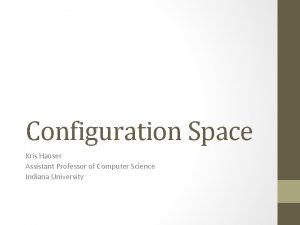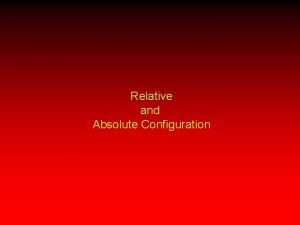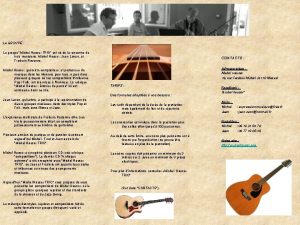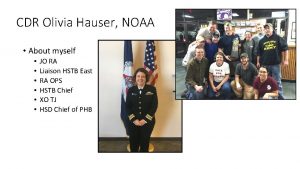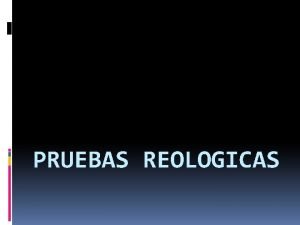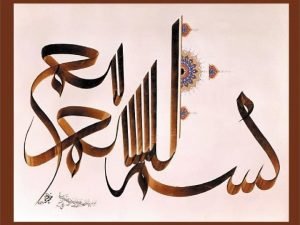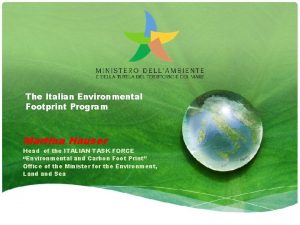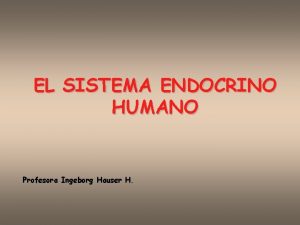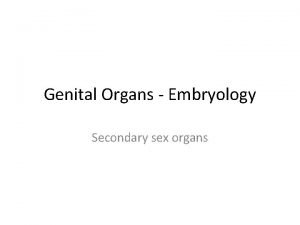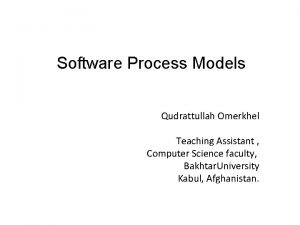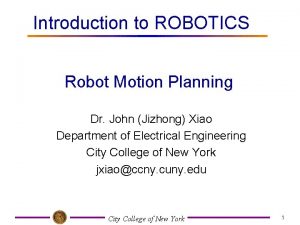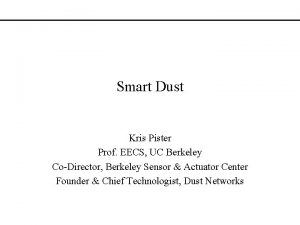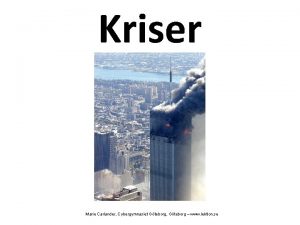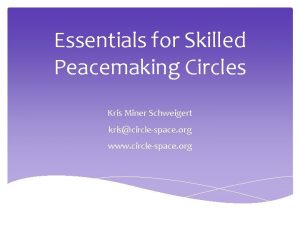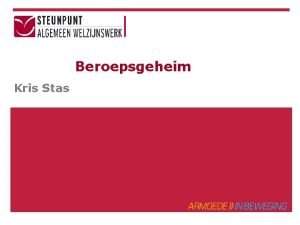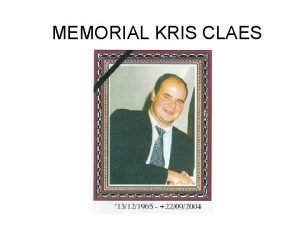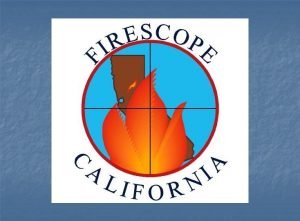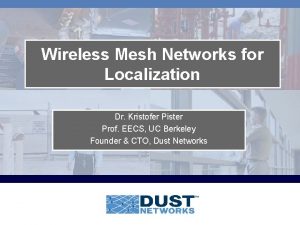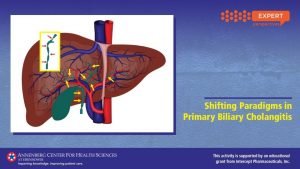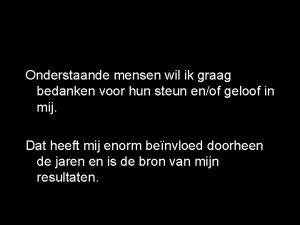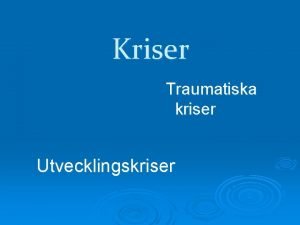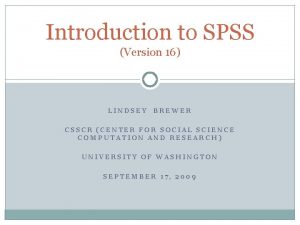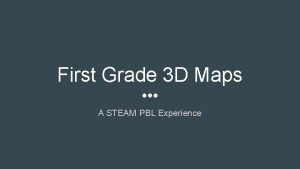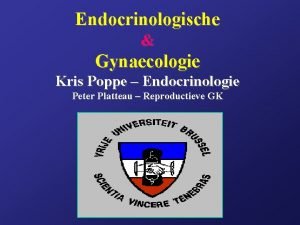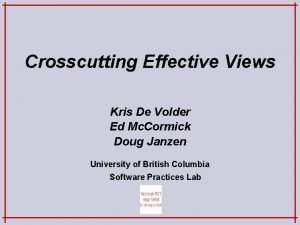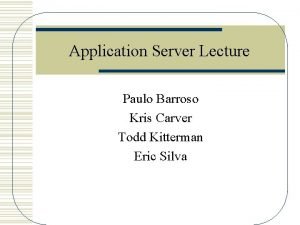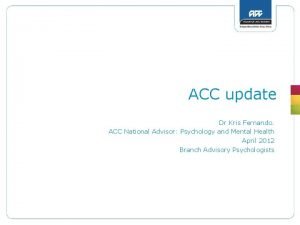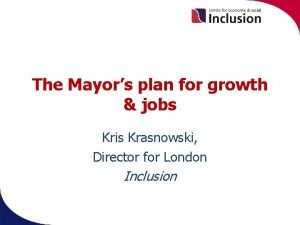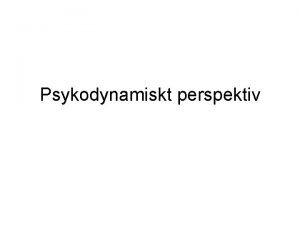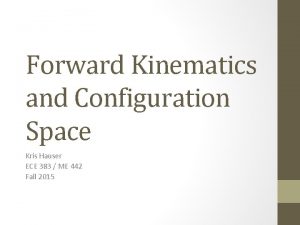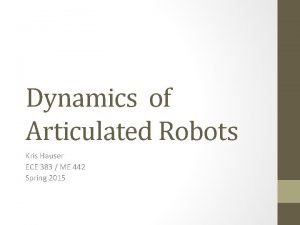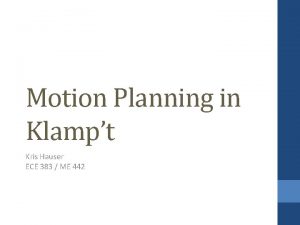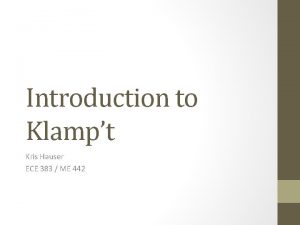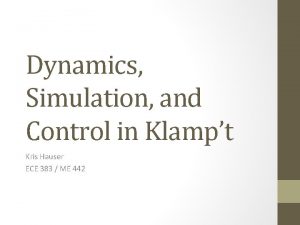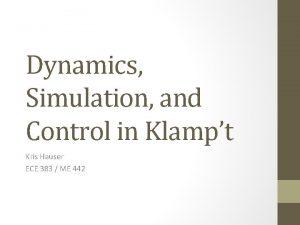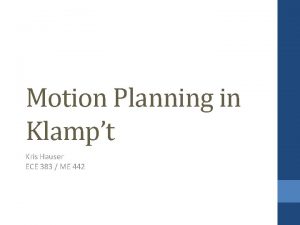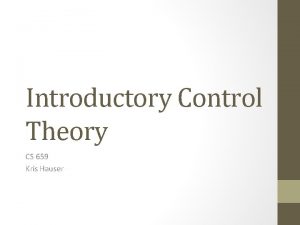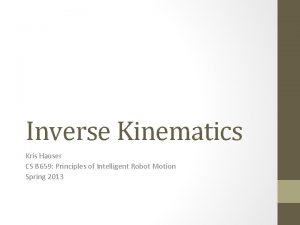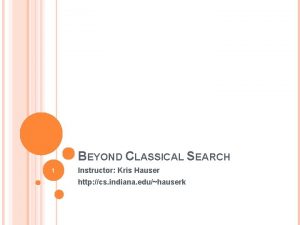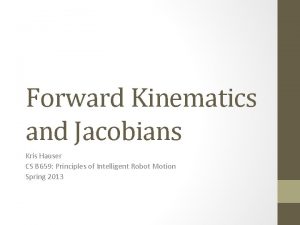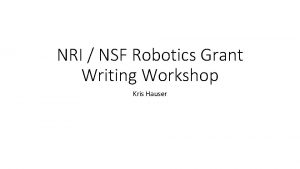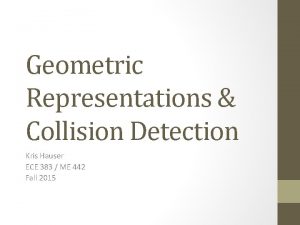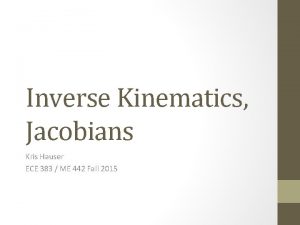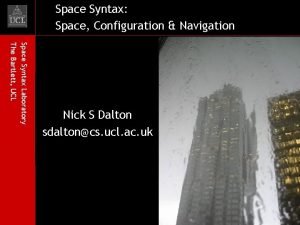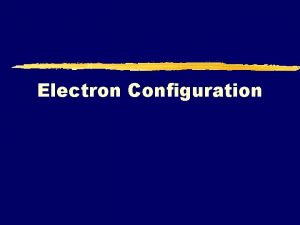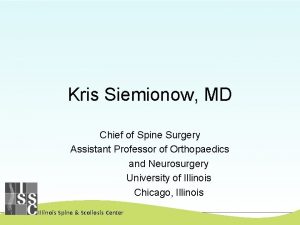Configuration Space Kris Hauser Assistant Professor of Computer














































- Slides: 46

Configuration Space Kris Hauser Assistant Professor of Computer Science Indiana University

Readings • Ch 3. 1 -3. 4 • * A Simple Motion-Planning Algorithm for General Robot Manipulators, T. Lozano-Perez, 1987. • * Spatial Planning: a Configuration Space Approach, T. Lozano-Perez, 1980.

Agenda • Introduce configuration spaces (C-spaces) • Lab 1: Install Robot. Sim

Definitions • Workspace: • The world in which a robot lives and occupies space • Usually 2 D (mobile robots) or 3 D (most other robots)

Robots have different shapes and kinematics! What is a motion?

Idea: Reduce robot to a point Configuration Space Feasible space Forbidden space

Configuration Space qn q=(q 1, …, qn) q 1 q 2 § A robot configuration is a specification of the positions of all robot points relative to a fixed q coordinate system 3 § Usually a configuration is expressed as a “vector” of parameters

Rigid Robot workspace robot y reference direction q reference point x • 3 -parameter representation: q = (x, y, q) • In a 3 -D workspace q would be of the form (x, y, z, a, b, g)

Articulated Robot q = (q 1, q 2, …, q 10) q 2 q 1

Protein

Configuration Space • Space of all its possible configurations • But the topology of this space is in general not that of a Cartesian space 3 -D cylinder embedded in 4 -D space robot q y q 2 p q y S 1 x q’ R 2 S 1 x

Configuration Space • Space of all its possible configurations • But the topology of this space is in general not that of a Cartesian space C = S 1 x S 1

Configuration Space • Space of all its possible configurations • But the topology of this space is in general not that of a Cartesian space C = S 1 x. S 1

Configuration Space • Space of all its possible configurations • But the topology of this space is in general not that of a Cartesian space C = S 1 x. S 1

Some Important Topological Spaces • • • R: real number line Rn: N-dimensional Cartesian space S 1: boundary of circle in 2 D S 2: surface of sphere in 3 D SO(2), SO(3): set of 2 D, 3 D orientations (special orthogonal group) SE(2), SE(3): set of rigid 2 D, 3 D translations and rotations (special Euclidean group) • Cartesian product A x B, power notation An = A x A … x A • Homeomorphism ~ denotes topological equivalence • • Continuous mapping with continuous inverse (bijective) Cube ~ S 2 SO(2) ~ S 1 SE(3) ~ SO(3) x R 3

What is its topology? (S 1)7 x. I 3 (I: Interval of reals) q 2 q 1

Structure of Configuration Space • It is a manifold, i. e. , for each point q, there is a 1 -to-1 map between a neighborhood of q and a Cartesian space Rn, where n is the dimensionality of C • This map is a local coordinate system called a chart. • C can always be covered by a finite number of charts. Such a set is called an atlas

Example: A sphere

Rigid Robot in 2 -D Workspace workspace robot y reference direction q reference point x • 3 -parameter representation: q = (x, y, q) with q [0, 2 p). Two charts are needed • Other representation: q = (x, y, cosq, sinq) C-space is a 3 -D cylinder R 2 x S 1 embedded in a 4 -D space

Rigid Robot in 3 -D Workspace • q = (x, y, z, a, b, g) • Other representation: q = (x, y, z, r 11, r 12, …, r 33) where r 11, r 12, …, r 33 are the elements of rotation matrix R: r 11 r 12 r 13 r 21 r 22 r 23 r 31 r 32 r 33 with: • ri 12+ri 22+ri 32 = 1 • ri 1 rj 1 + ri 2 r 2 j + ri 3 rj 3 = 0 • det(R) = +1

Rigid Robot in 3 -D Workspace • q = (x, y, z, a, b, g) The c-space is a 6 -D space (manifold) embedded • Other representation: q = (x, y, z, r in a 12 -D Cartesian space. It is denoted by 33) 11, r 12, …, r where r 11, r 12, …, r 33 are the elements of rotation matrix SE(3) =R: R 3 x. SO(3) r 11 r 12 r 13 r 21 r 22 r 23 r 31 r 32 r 33 with: • ri 12+ri 22+ri 32 = 1 • ri 1 rj 1 + ri 2 r 2 j + ri 3 rj 3 = 0 • det(R) = +1

Parameterization of SO(3) § Euler angles: (f, q, y) z z y f 1 2 3 4 y q y x § More next time y x x x y

Notion of a (Geometric) Path q 0 q 1 q 2 qn t(s) q 4 q 3 • A path in C is a piece of continuous curve connecting two configurations q and q’: t : s [0, 1] t (s) C

Examples • A straight line segment linearly interpolating between a and b • t(s) = (1 -s) a + s b • What about interpolating orientations? • A polynomial with coeffients c 0, …, cn • t(s) = c 0 + c 1 s + … + cnsn • Piecewise polynomials • Piecewise linear • Splines (B-spline, hermite splines are popular) • Can be an arbitrary curve • Only limited by your imagination and representation capabilities

Notion of Trajectory vs. Path q 0 q 1 q 2 qn t(t) q 4 q 3 • A trajectory is a path parameterized by time: t [0, T] t (t) C

Translating & Rotating Rigid Robot in 2 -D Workspace q workspace configuration space 2 p robot reference direction q y y reference point x What is the placement of the robot in the workspace at configuration (0, 0, 0)? x

Translating & Rotating Rigid Robot in 2 -D Workspace q workspace configuration space 2 p robot reference direction q y y reference point x What is the placement of the robot in the workspace at configuration (0, 0, 0)? x

Translating & Rotating Rigid Robot in 2 -D Workspace q workspace configuration space What is this path in the workspace? 2 p robot reference direction y q P y reference point x What would be the path in configuration space corresponding to a full rotation of the robot about point P? x

Every robot maps to a point in its configuration space. . . ~40 D 15 D 6 D q 0 12 D q 1 qn ~65 -120 D q 4 q 3

. . . and every robot path is a curve in configuration space q 0 q 1 qn q 4 q 3

… and obstacles (and other constraints) map to configuration space obstacles ~40 D 15 D 6 D q 0 12 D q 1 qn ~65 -120 D q 4 q 3

Obstacles in C-Space • A configuration q is collision-free, or free, if the robot placed at q has null intersection with the obstacles in the workspace • The free space F is the set of free configurations • A C-obstacle is the set of configurations where the robot collides with a given workspace obstacle • A configuration is semi-free if the robot at this configuration touches obstacles without overlap

Disc Robot in 2 -D Workspace W Configuration space C path y x configuration = coordinates (x, y) of robot’s center configuration space C = {(x, y)} free space F = subset of collision-free configurations

Translating Polygon in 2 -D Workspace reference point

Translating & Rotating Polygon in 2 -D Workspace

Articulated 2 -Joint Robot

Some constraints can’t be modeled as C-Space obstacles • Differential constraints: smoothness, finite curvature, drift, etc… • Global constraints: finite length, power consumption, etc…

Homotopic Paths • Two paths with the same endpoints are homotopic if one can be continuously deformed into the other • Rx. S 1 example: q t 3 t 1 • t 1 and t 2 are homotopic • t 1 and t 3 are not homotopic • In this example, infinity of homotopy classes t 2 q’

Connectedness of C-Space • C is connected if every two configurations can be connected by a path • C is simply-connected if any two paths connecting the same endpoints are homotopic Examples: R 2 or R 3 • Otherwise C is multiply-connected Examples: S 1 and SO(3) are multiply-connected: - In S 1, infinity of homotopy classes - In SO(3), only two homotopy classes

Homotopy of Free Paths

Recap • Configuration space: • Tool to map a robot in a 2 -D or 3 -D workspace into a point in n-D space • Topological spaces • Mapping obstacles into C-space

Readings • Principles Ch. 3. 5 -3. 8, Appendix E

Notions of Continuity • Path continuity (geometric, or C 0) • For all s, d(t(s), t(s’)) -> 0 as s’->s • Trajectory continuity (geometric, or C 0) • For all t, d(t(t), t(t’)) -> 0 as t’->t • Higher order continuity • C 1: For all t, t’(t) is well defined • C 2: For all t, t’’(t) is well defined • …

Metric in Configuration Space A metric or distance function d in C is a map d: (q 1, q 2) C 2 d(q 1, q 2) > 0 such that: • d(q 1, q 2) = 0 if and only if q 1 = q 2 • d(q 1, q 2) = d (q 2, q 1) • d(q 1, q 2) < d(q 1, q 3) + d(q 3, q 2)

Metric in Configuration Space Example: • Robot A and point x of A • x(q): location of x in the workspace when A is at configuration q • A distance d in C is defined by: d(q, q’) = maxx A ||x(q)-x(q’)|| where ||a - b|| denotes the Euclidean distance between points a and b in the workspace

Specific Examples in R 2 x S 1 § q = (x, y, q), q’ = (x’, y’, q’) with q, q’ [0, 2 p) § a = min{|q-q’| , 2 p-|q-q’|} q a § d(q, q’) = sqrt[(x-x’)2 + (y-y’)2 + a 2] § d(q, q’) = sqrt[(x-x’)2 + (y-y’)2 + (ar)2] where r is the maximal distance between the reference point and a robot point q’
 Kris hauser
Kris hauser Promotion from associate professor to professor
Promotion from associate professor to professor Cuhk salary scale 2020
Cuhk salary scale 2020 Cisco configuration assistant (cca)
Cisco configuration assistant (cca) Relative configuration
Relative configuration Relative configuration
Relative configuration Electron configuration vs noble gas configuration
Electron configuration vs noble gas configuration Relative vs absolute configuration
Relative vs absolute configuration Marc d hauser
Marc d hauser Michel hauser
Michel hauser Vitellüs kesesi
Vitellüs kesesi Dr jay hauser
Dr jay hauser Celutab
Celutab Research ethics definition
Research ethics definition Martina hauser
Martina hauser Ingeborg hauser
Ingeborg hauser Mayer-rokitansky-küster-hauser syndrome
Mayer-rokitansky-küster-hauser syndrome Assistant computer control
Assistant computer control Potential field
Potential field Kris fernando
Kris fernando Kris kmitl
Kris kmitl Kris pister
Kris pister överdeterminerad kris
överdeterminerad kris Kris francken oekraine
Kris francken oekraine Kris miner
Kris miner Kris stas
Kris stas Wade kerrigan husch blackwell
Wade kerrigan husch blackwell Keith ferry norwich canaries
Keith ferry norwich canaries Kris kmitl
Kris kmitl Kris wui
Kris wui Kristofer pister
Kristofer pister Kris kmitl
Kris kmitl Kris wui
Kris wui Kris kowdley
Kris kowdley Kris dumont
Kris dumont Känslomässig avstängdhet
Känslomässig avstängdhet Spss version 16
Spss version 16 Kris krider
Kris krider Kris caldwell
Kris caldwell Kris poppe
Kris poppe Kris de volder
Kris de volder Kris hildrum
Kris hildrum Kris carver
Kris carver Kris fernando
Kris fernando Kris krasnowski
Kris krasnowski Medvetna och omedvetna signaler tema
Medvetna och omedvetna signaler tema Sand colic
Sand colic
